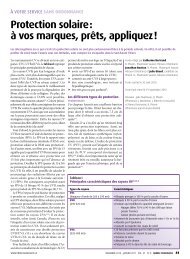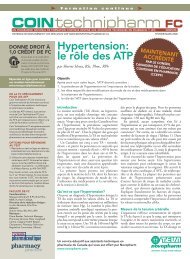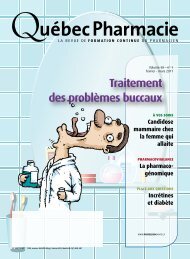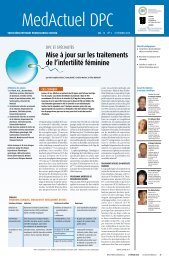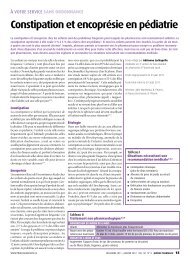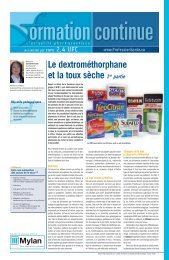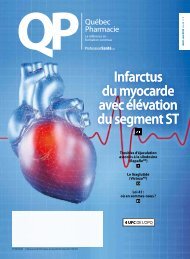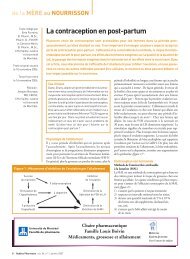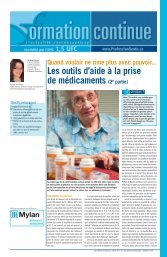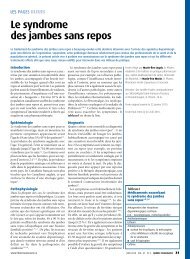Les antidépresseurs durant la grossesse : des ... - Profession Santé
Les antidépresseurs durant la grossesse : des ... - Profession Santé
Les antidépresseurs durant la grossesse : des ... - Profession Santé
- No tags were found...
You also want an ePaper? Increase the reach of your titles
YUMPU automatically turns print PDFs into web optimized ePapers that Google loves.
Intoxication par l’acide valproïque secondaire à une hypo-albuminémie Suite de <strong>la</strong> page 52difficile d’accès. À l’heure actuelle, <strong>la</strong> pierre angu<strong>la</strong>ire en matièred’intoxication par l’acide valproïque demeure l’arrêt rapide dumédicament. Le traitement de soutien a aussi une grande importanceen ce qui concerne le sou<strong>la</strong>gement <strong>des</strong> signes et <strong>des</strong> symptômesassociés. La décontamination gastro-intestinale peut êtrerecommandée dans certaines situations. De plus, on peut envisagerun traitement spécifique par <strong>la</strong> naloxone et <strong>la</strong> L-carnitine dans lescas plus graves. Enfin, les techniques d’élimination extracorporellesont réservées aux cas réfractaires. nRéférences1. Sechi G, Serra A. Wernicke’s encephalopathy : new clinical settings and recentadvances in diagnosis and management. Lancet Neurol 2007; 6(5) : 442-55.2. Abbott Laboratories Limited. Monographie canadienne d’Epival MD . Ville St-Laurent(Québec); mai 2008.3. Haroldson JA, Kramer LE, Wolff DL et coll. Elevated free fractions of valproicacid in a heart transp<strong>la</strong>nt patient with hypoalbuminemia. Ann Pharmacother2000; 34(2) : 183-7.4. Kodama Y, Tsutsumi K, Teraoka I et coll. Effect of unbound clearance on bindingparameters of valproic acid to serum proteins. J Clin Pharmacol 1993; 33(2) :130-5.5. Hermida J, Tutor JC. A theoretical method for normalizing total serum valproicacid concentration in hypoalbuminemic patients. J Pharmacol Sci 2005; 97(4) :489-93.6. Pirmohamed M, Park BK. Adverse drug reactions : back to the future. Br J ClinPharmacol 2003; 55(5) : 486-92.7. Riedl MA, Casil<strong>la</strong>s AM. Adverse drug reactions : types and treatment options.Am Fam Physician 2003 ; 68(9) : 1781-90.8. Piermohamed M, Ferner RE. Monitoring drug treatment. BMJ 2003; 327(7425): 1179-81.9. Dasgupta A. Usefulness of monitoring free (unbound) concentration of therapeuticdrugs in patient management. Clin Chim Acta 2007; 377(1-2) : 1-13.10. MacKichan JJ. Influence of protein binding and the use of unbound (free) drugconcentrations. Dans : Evans WE, Schentag JJ, Jusko WJ. Applied pharmacokinetics.3 e éd. Applied Therapeutics, Vancouver, 1992 : 5-1-5-48.11. Levy RH, Wilensky AJ, Anderson GD. Carbamazepine, valproic acid, phenobarbial,and ethusoximide. Dans : Evans WE, Schentag JJ, Jusko WJ. Applied pharmacokinetics.3 e éd. Applied Therapeutics, Vancouver, 1992 : 26-1-26-29.12. Manoguerra AS, Erdman AR, Woolf AD et coll. Valproic acid poisoning : an evidence-basedconsensus guideline for out-of-hospital management. Clin toxicol2008; 46(7) : 661-76.13. Bédry R, Parrot F. Intoxications graves par l’acide valproïque. Réanimation2004; 13(5) : 324-333.14. Gerstner T, Buesing D, Longin E et coll. Valproic acid induced encephalopathy– 19 new cases in Germany from 1994 to 2003 – A side effect associated to VPAtherapynot only in young children. Seizure 2006; 15(6) : 443-8.15. Parize P, Beuret P, Fischer C. Une encéphalopathie au valproate sans hyperammoniémie.Ann Fr Anesth Reanim 2007; 26(12) : 1084-5.16. Chan YC, Tse ML, Lau FL. Two cases of valproic acid poisoning treated withL-carnitine. Hum Exp Toxicol 2007; 26(12) : 967-9.17. L’heureux PE, Penaloza A, Zahir S et coll. Science review : carnitine in thetreatment of valproic acid-induced toxicity – what is the evidence ? Crit care2005; 9(5) : 431-40.18. Atti<strong>la</strong>kos A, Voudris KA, Katsarou E et coll. Transient decreased serum albuminconcentrations in epileptic children treated with sodium valproate monotherapy.Clin Neuropharmacol 2007; 30(3) : 145-9.19. Lagneau F, Perbet S, Delefosse D et coll. Drugs pharmacokinetics in ICUpatients : consequences of hypoalbuminemia upon drugs monitoring and dosingscheme. Intensive Care Med 2004; 30(6) : 1247.20. Naranjo CA, Busto U, Sellus EM et coll. A method for estimating the probabilityof adverse drug reactions. Clin Pharmacol Ther 1981; 30(2) : 74-80.21. Thanacoody HK. Chronic valproic acid intoxication : reversal by naloxone. EmergMed J 2007; 24(9) : 677-8.Questions de formation continue15) Parmi les énoncés suivants, lequel est faux ?A. Le pharmacien peut jouer un rôle déterminant dans<strong>la</strong> prévention <strong>des</strong> effets indésirables médicamenteuxet <strong>des</strong> intoxications médicamenteuses.B. La L-carnitine devrait être utilisée chez tous les patientsintoxiqués par l’acide valproïque.C. La naloxone peut s’avérer utile pour renverser <strong>la</strong>dépression du SNC.D. Le traitement de soutien demeure le principaltraitement d’une intoxication par l’acide valproïque.E. Le monitorage <strong>des</strong> concentrations libres est particulièrementrecommandé chez les patients avec atteinteshépatique et/ou rénale, les patients avec hypoalbuminémieou lorsqu’on suspecte une interaction médicamenteuse.16) Parmi les énoncés suivants, lequel est vrai ?A. Il est indiqué d’effectuer un monitorage <strong>des</strong> concentrationssanguines pour tous les médicaments.B. Pour les médicaments à faible extraction hépatique,lorsque <strong>la</strong> concentration totale est en <strong>des</strong>sous del’intervalle thérapeutique en présence d’une hypo-albuminémie,il faut augmenter <strong>la</strong> dose afin d’obtenir uneconcentration totale dans l’intervalle thérapeutique.C. En présence d’une hypo-albuminémie, l’augmentationde <strong>la</strong> concentration libre et de <strong>la</strong> réponse pharmacologiqued’un médicament à forte extraction hépatiqueest plus importante, comparativement à un médicamentà faible extraction hépatique.D. L’hémodialyse et l’hémoperfusion sont toujoursinutiles dans un contexte d’intoxication par l’acidevalproïque puisque cette molécule se lie fortement auxprotéines p<strong>la</strong>smatiques.E. L’administration de charbon activé est particulièrementindiquée dans les cas d’intoxication chronique parl’acide valproïque.Veuillez reporter vos réponsesdans le formu<strong>la</strong>ire de <strong>la</strong> page 90 www.monportailpharmacie.caseptembre 2009 vol. 56 n° 5 Québec Pharmacie 55



